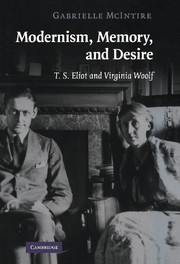Book contents
- Frontmatter
- Contents
- Illustration
- Acknowledgments
- Introduction
- 1 An unexpected beginning: sex, race, and history in T. S. Eliot's Columbo and Bolo poems
- 2 Mixing memory and desire: rereading Eliot and the body of history
- 3 Eliot, eros, and desire: “Oh, do not ask, ‘What is it?’”
- 4 T. S. Eliot: writing time and blasting memory
- 5 Virginia Woolf, (auto)biography, and the eros of memory: reading Orlando
- 6 Other kinds of autobiographies: sketching the past, forgetting Freud, and reaching the lighthouse
- 7 Remembering what has “almost already been forgotten”: where memory touches history
- Epilogue
- Notes
- Index
7 - Remembering what has “almost already been forgotten”: where memory touches history
Published online by Cambridge University Press: 22 September 2009
- Frontmatter
- Contents
- Illustration
- Acknowledgments
- Introduction
- 1 An unexpected beginning: sex, race, and history in T. S. Eliot's Columbo and Bolo poems
- 2 Mixing memory and desire: rereading Eliot and the body of history
- 3 Eliot, eros, and desire: “Oh, do not ask, ‘What is it?’”
- 4 T. S. Eliot: writing time and blasting memory
- 5 Virginia Woolf, (auto)biography, and the eros of memory: reading Orlando
- 6 Other kinds of autobiographies: sketching the past, forgetting Freud, and reaching the lighthouse
- 7 Remembering what has “almost already been forgotten”: where memory touches history
- Epilogue
- Notes
- Index
Summary
It is, if you like, the unrolling of a spool, for there is no living being who does not feel himself coming little by little to the end of his span; and living consists in growing old. But it is just as much a continual winding, like that of thread into a ball, for our past follows us, becoming larger and larger with the present it picks up on its way; and consciousness means memory.
Henri Bergson, “Introduction to Metaphysics”[T]he past is beautiful because one never realises an emotion at the time. It expands later, & thus we don't have complete emotions about the present, only about the past. This struck me on Reading platform, watching Nessa & Quentin kiss, he coming up shyly, yet with some emotion. This I shall remember.
Virginia Woolf, Diary, 18 March 1925The past is literally blasted into consciousness with the Blitz in London.
H.D., Tribute to FreudWhile Woolf argues for a fundamental indestructibility of the past, she also feared the powers and the contagion of cultural amnesia. As the First World War was coming to an end, and peace looked almost certain, she worried that “people will soon forget all about the war, & the fruits of our victory will grow as dusty as ornaments under glass cases in lodging house drawing rooms.”
- Type
- Chapter
- Information
- Modernism, Memory, and DesireT. S. Eliot and Virginia Woolf, pp. 180 - 208Publisher: Cambridge University PressPrint publication year: 2008



